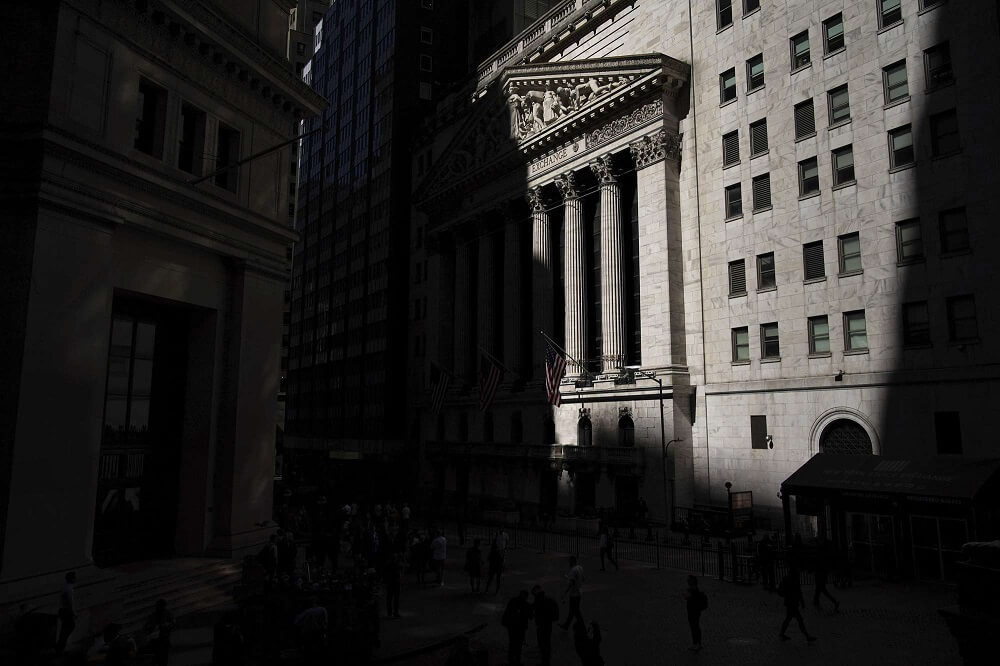Monday’s Dow Jones Rampage Is the Worst Kind of Stock Market Rally

Options markets - which are ruled by the “smart money” and largely stripped of retail “noise” - are pricing in far more downside risk for the stock market than upside potential. | Source: Drew Angerer/Getty Images/AFP
- The Dow Jones rose nearly 1,000 points on Monday as traders reacted to positive news about Moderna’s coronavirus vaccine trials.
- The stock market’s upward pivot mirrored the move it made last month as optimism grew around another coronavirus drug.
- Even if Wall Street’s risk sentiment is justified, today’s meteoric rally should give investors pause.
The Dow Jones Industrial Average (DJIA) went absolutely ballistic on Monday, as spectacular news about Moderna’s coronavirus vaccine trials sent the index on a 911-point rampage.
But for all of Wall Street’s raging optimism, today’s stock market surge is the worst kind of rally. History suggests bulls should temper their expectations – and maybe even brace for an oncoming sell-off.
Today’s Meteoric Stock Market Rally Should Give Investors Deja Vu

There’s no question that the early results from biotech firm Moderna’s coronavirus vaccine trials are encouraging . CEO Stephane Bancel went so far as to tell shareholders that the vaccine has a “high probability to provide protection from COVID-19 disease in humans.”
But there’s also no question that stock market bulls are desperate for a reason to price out further damage from the coronavirus pandemic. And in that desperation, they frequently allow their optimism to exceed fundamentals.
Recall that just one month ago, the stock market surged when a Gilead Sciences trial suggested that remdesivir might be an effective treatment for severe COVID-19 symptoms .

The news about remdesivir has only improved in the weeks that followed. And yet last Friday, the S&P 500 closed 11 points lower than it had when the initial headlines about remdesivir’s effectiveness broke on April 17.
There’s a very real risk that investors are doing the same thing here.
Even today’s opening bell bounce should spark some remdesivir deja vu. It was a near mirror-image of the gap higher that equities made after Gilead announced the results of its phase 3 trials on April 29.

The stock market has not made meaningful progress since the remdesivir hype-cycle kicked into high gear. And that’s with subsequent news confirming the initial optimism.
That’s not a certainty with Moderna.
As an NBC News report notes, phase 1 trials are extremely limited in scope. And crucially, they don’t “study whether a drug works.”:
The goal of phase 1 trials is to evaluate the safety of a new drug in a small group of participants, not effectiveness. Phase 2 trials study whether a drug works.
Even if it works and gest fast-tracked for approval, it’s not clear when it will be available en masse. The timeline matters, especially since health officials warn that coronavirus outbreaks could flare up again once flu season returns in the fall.
That makes today’s rally a prime example of investor sentiment outstripping fundamentals, potentially by a wide margin. It’s the kind of rally that leaves stocks vulnerable to a swift pullback.
Historical Data and Options Markets Highlight Downside Risks for the Dow
But even if Monday’s hopium injection doesn’t ultimately send equity prices on a bad trip in the short term, history suggests investors may want to sober up.
Almost all of the stock market’s best days come during ugly years. And of the Dow’s most aggressive single-day rallies, only a handful have come after the index has already hit the bottom of a bear market cycle.
The simple fact is that big swings tend to beget more volatility, and that volatility strikes both ways.

That should concern investors because options markets – which are ruled by the “smart money” and largely stripped of retail “noise” – are pricing in far more downside risk for the stock market than upside potential .
According to Janus Henderson Investors, options on the top 100 stocks in the S&P 500 currently imply about 40% more downside than upside.
That’s an eerie parallel to the final months of 2008, when the stock market rallied after the Federal Reserve took then-unprecedented steps to rescue a flailing economy.
The economy did recover, but not before the Dow and S&P 500 spent early 2009 plumbing new lows.
Disclaimer: This article represents the author’s opinion and should not be considered investment or trading advice from CCN.com. Unless otherwise noted, the author has no position in any of the stocks mentioned.